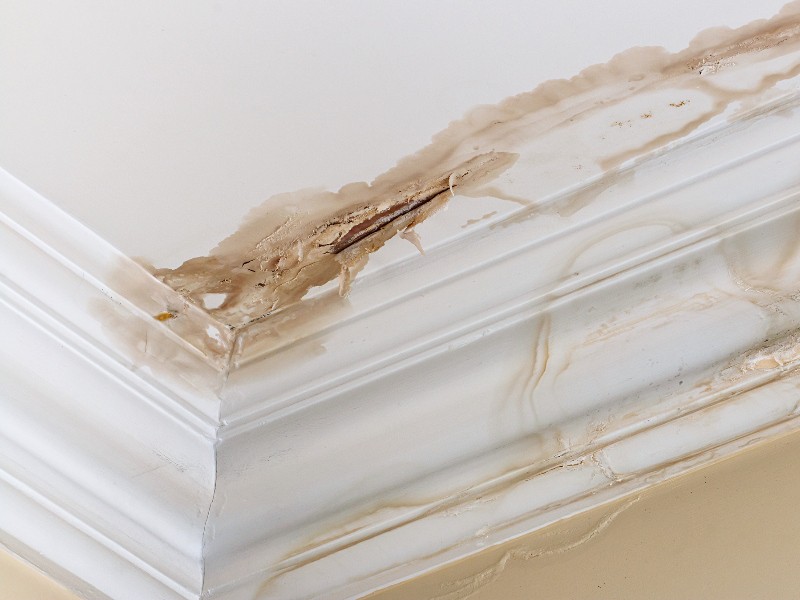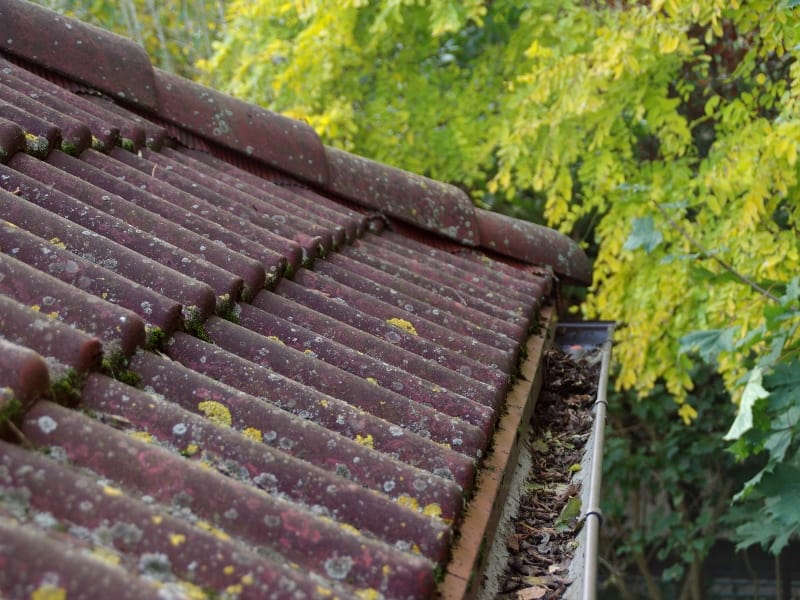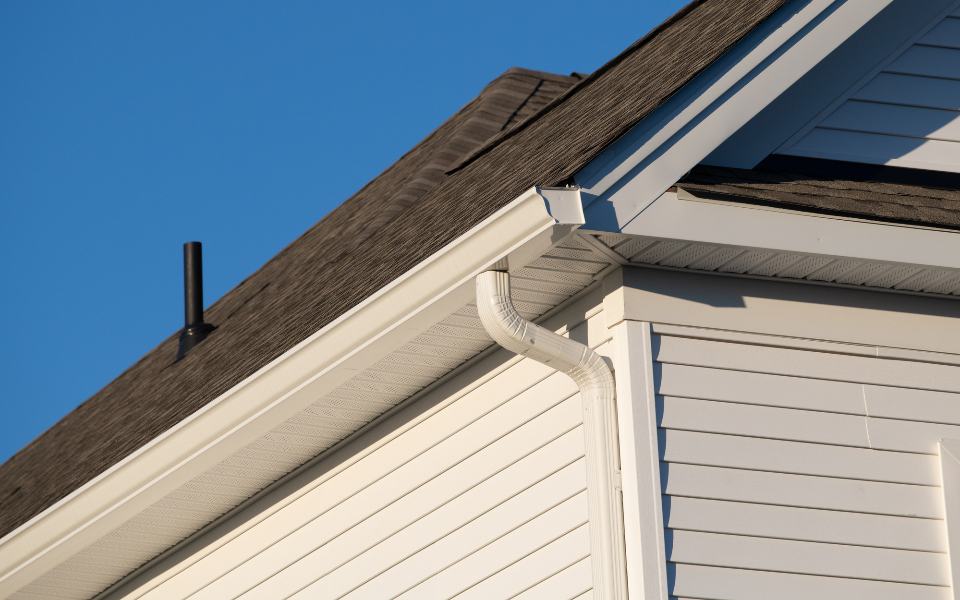Gutters play a crucial role in preventing roof damage. They serve as a drainage system for rainwater, redirecting it away from the roof and the foundation of a house. By collecting the rainwater that runs off the roof, gutters ensure that it does not accumulate and seep into the roof structure or foundation, which can lead to costly repairs. Without gutters, rainwater would fall directly off the roof in an uncontrolled manner, potentially causing erosion of the soil around the foundation and damaging the roof shingles or tiles. The accumulation of water on the roof can also lead to the formation of ice dams during freezing temperatures, which can further weaken the roof and cause leaks. Gutters effectively prevent these issues by channeling the rainwater away from the roof and directing it to a safe distance from the house. In this way, gutters help maintain the integrity of the roof, prolong its lifespan, and protect the overall structure of the house.
What Are Gutters?
Gutters help prevent roof damage and are an essential component of any house’s roofing system. They are narrow channels or troughs that are installed along the edges of the roof to collect and divert rainwater away from the building’s foundation. The primary purpose of gutters is to help prevent roof damage by directing the flow of water away from the house. When it rains, water naturally cascades down the roof, and without gutters, it can collect near the foundation, leading to potential water damage and erosion. This excess water can seep into the soil, causing the foundation to settle or crack over time. Gutters efficiently capture rainwater and direct it towards downspouts, which carry the water safely away from the house and into drainage systems. By doing so, gutters help protect the roof, walls, and foundation of a house from the potential harm caused by water accumulation. Properly installed and maintained gutters help prevent roof damage and play a crucial role in maintaining the structural integrity of a home and preventing costly repairs.
Definition and functions of gutters
Gutters help prevent roof damage and are an essential component of a building’s drainage system. They are narrow channels or troughs that collect rainwater and guide it away from the roof and the foundation of the building. The primary function of gutters is to prevent water damage to the roof and walls of a structure. By channeling rainwater, gutters help protect roofs from potential leaks, rotting, and erosion caused by water pooling on the surface. Gutters help prevent roof damage and also play a crucial role in preventing damage to the foundation of a building. The water collected by gutters is directed away from the foundation, preventing potential flooding and soil erosion that can compromise the stability of the structure. This not only protects the overall integrity of the building but also helps to maintain its aesthetic appeal by preventing water stains and damage to walls and exterior surfaces. Gutters help prevent roof damage and are an important investment that ensures the longevity and quality of a building.
Different types of gutters available
Gutters play a crucial role in preventing roof damage and maintaining the overall integrity of a building. There are various types of gutters available in the market, each with its own distinct features and advantages. The most common type of gutters is seamless aluminum gutters, which are lightweight, cost-effective, and low-maintenance. These gutters have no seams, making them less prone to leaks and clogs. Another popular option is vinyl gutters, which are lightweight, easy to install, and resistant to rust and corrosion. Copper gutters, on the other hand, are known for their durability, aesthetic appeal, and longevity. They develop a beautiful patina over time, adding character to the building’s exterior. Additionally, stainless steel gutters offer high strength and durability, making them suitable for areas with extreme weather conditions. Each type of gutter serves the purpose of protecting the roof from water damage by efficiently redirecting rainwater away from the building. It is important to choose the right type of gutter that suits the specific needs and climate of the region to ensure proper functioning and longevity of the gutters. Our specialists at Old Line Roofing and Solar can discuss the importance of gutter systems and also the best type for your home’s needs.
The Role of Gutters in Preserving Your Roof
Gutters help prevent roof damage and play a crucial role in preserving the lifespan of your roof. Gutters help prevent roof damage by efficiently redirecting rainwater away from the surface. Without gutters, rainwater would simply run off the roof and pool around the foundation, causing erosion and potential structural damage. By directing the water into a controlled flow, gutters prevent excessive water accumulation on the roof, which can lead to leaks, rotting, and water damage. Furthermore, gutters protect the roof’s shingles or tiles from excessive wear and tear caused by the constant flow of water. This is particularly important during heavy rainstorms or snow melting, as the volume of water increases significantly. Gutters also help prevent ice dams from forming along the edge of the roof by providing a pathway for melted snow to flow off the roof. Overall, gutters are an essential component of roof maintenance as they contribute to its longevity and protect against potential damage.
How gutters redirect water away from the roof
Gutters help prevent roof damage and play a vital role in protecting a roof from potential damage caused by water accumulation. They are designed to redirect rainwater away from the roof, ensuring it does not collect and seep into the structure. When it rains, gutters collect the water that falls on the roof and channel it into downspouts and away from the building’s foundation. This redirection prevents water from pooling on the roof, which can lead to leaks, rotting, and other significant issues. Gutters help prevent roof damage by ensuring that water flows away from the roof and the foundation, effectively protecting the structural integrity of the building. Without gutters, water could accumulate and gradually seep into the roof, causing water damage, mold growth, and potential structural problems. Therefore, it is essential to have properly installed and maintained gutters to safeguard the roof and extend its lifespan.
The consequences of water pooling on the roof
Water pooling on the roof can have numerous negative consequences. One of the main issues is the potential for roof damage. When water accumulates and pools on the roof, it can seep into the underlying layers and cause structural deterioration. This can lead to leaks, sagging, and overall weakening of the roof’s integrity. Additionally, the weight of the pooled water can exert undue pressure on the roof, causing it to become overloaded and potentially collapse. Another consequence of water pooling is the increased risk of water infiltration into the building. If the roof becomes compromised, water can find its way inside, damaging insulation, walls, and furniture. Moreover, water pooling can also result in the growth of mold and mildew, which pose health hazards and can deteriorate the indoor air quality. To mitigate these issues, gutters play a crucial role. Gutters help prevent roof damage by redirecting water away from the roof, ensuring proper drainage and reducing the likelihood of pooling. By keeping the roof dry, gutters contribute to the longevity and durability of the structure.
Ways gutters prevent water damage to the roof
Gutters help prevent roof damage and play a crucial role in preventing water damage to the roof. Firstly, they channel rainwater away from the roof, preventing it from accumulating and causing structural issues. Without gutters, rainwater can seep into the roof, leading to leaks, rot, and even the deterioration of underlying materials. Moreover, gutters help prevent roof damage and also ensure that water does not overflow and splash back onto the roof, which can cause water damage over time. They direct water away from the roof’s edges and foundation, protecting them from erosion and potential damage. Additionally, gutters help prevent roof damage and prevent the formation of ice dams, which can occur when snow melts and refreezes around the edges of the roof. Ice dams not only cause water to back up onto the roof but also exert pressure, ultimately leading to leaks in the roof. In summary, gutters help prevent roof damage by effectively diverting water away from the roof, protecting it from water infiltration, erosion, and ice dams.

Protecting Against Water Damage
One of the essential ways to protect our homes from water damage is by utilizing gutters. Gutters play a crucial role in preventing roof damage caused by water. When it rains, water is collected in the gutters and directed away from the roof and foundation of the house. This prevents water from seeping into the structure, which can lead to various types of damage such as rotting wood, mold growth, and foundation cracks. Additionally, gutters help prevent roof damage and control the flow of rainwater, ensuring that it does not overflow and cause pooling around the foundation. By diverting water away from vulnerable areas, gutters provide an effective defense against water damage. Regular maintenance and cleaning of gutters are necessary to ensure their proper functioning and to avoid blockages that can lead to water backup. Therefore, investing in a high-quality gutter system and keeping it clean is an important step in protecting our homes from costly water damage.
How gutters prevent basement and foundation flooding
Gutters help prevent roof damage and play a crucial role in preventing basement and foundation flooding. When it rains, water naturally flows down the roof and if there are no gutters, it can pour directly onto the ground surrounding the house. This can lead to the soil becoming saturated and increasing the risk of water seeping into the basement or foundation. Gutters divert the flow of rainwater away from the house, directing it into downspouts and safely away from the foundation. By guiding the water away, gutters help maintain the integrity of the foundation and prevent it from becoming weakened or damaged by excess moisture. Additionally, gutters help prevent roof damage by keeping rainwater from overflowing and accumulating on the roof’s surface. This not only protects the structural integrity of the roof but also prevents the growth of mold and mildew, which can cause further damage. In summary, gutters are an essential component in safeguarding the basement, foundation, and roof of a house from flooding and potential water-related issues.
Preventing erosion around the house
One effective way to prevent erosion around the house is to install gutters. Gutters help redirect rainwater away from the foundation of the house, preventing soil erosion and potential damage to the structure. Without gutters, rainwater would pour off the roof and directly onto the ground, causing the soil around the foundation to become saturated and potentially leading to erosion. This can weaken the foundation over time, resulting in costly repairs. By directing the rainwater away from the house, gutters ensure that the soil remains stable and intact, reducing the risk of erosion. Additionally, gutters also help prevent roof damage by collecting and channeling rainwater towards downspouts, preventing it from pooling on the roof and causing leaks or other types of damage. Installing gutters is a simple and effective way to prevent erosion and protect both the foundation and the roof of the house.
Avoiding damage to landscaping and exterior structures
One important aspect of maintaining a landscape and exterior structure is avoiding damage to them. One effective way to prevent damage is by ensuring that gutters are installed and functioning properly. Gutters help prevent roof damage by directing rainwater away from the roof and foundation of a building. When it rains, gutters collect water from the roof and carry it away, preventing it from pooling and causing damage to the structure. By diverting the water away from the building, gutters protect the landscaping and prevent soil erosion. It is also important to regularly clean and maintain gutters to ensure they are free from debris and allow water to flow smoothly. Another way to avoid damage to landscaping and exterior structures is by properly positioning plants, trees, and shrubs. Planting them away from the foundation of the building and providing adequate space between plants and structures can help mitigate the risk of roots damaging foundations, moisture accumulation, or overgrowth causing structural damage. Regular inspections and proactive maintenance can go a long way in preserving the integrity and aesthetics of the landscape and exterior structures.
Preventing Ice Dams and Roof Leaks
Ice dams and roof leaks can cause significant damage to a house if not prevented. One effective way to prevent these issues is by properly maintaining and installing gutters. Gutters help prevent water damage and are designed to collect and redirect water away from the roof and foundation of a house. By doing so, they help prevent water from pooling on the roof, which can lead to the formation of ice dams. Ice dams occur when the trapped water freezes and expands, causing damage to the roof and potential leaks into the house. By directing water away from the roof, gutters help prevent roof damage and also help to prevent roof leaks. Without gutters, rainwater can run down the sides of a house and seep into the roof, causing water damage and potential leaks. Therefore, regular maintenance of gutters, including cleaning and ensuring proper installation, is essential in preventing ice dams and roof leaks.
Ice dams and their impact on the roof
Ice dams occur when heat from inside the house causes the snow on the roof to melt. As the melted snow flows down the roof, it reaches the colder eaves, where it refreezes. This frozen layer of ice creates a dam, trapping the remaining melting snow behind it. As the snow continues to melt, the trapped water has nowhere to go but up under the shingles, leading to leaks and water damage inside the house. Ice dams can have a significant impact on the roof, causing damage to the shingles, gutters, and even the structural integrity of the roof. The weight of the ice can put strain on the roof, leading to sagging or even collapse in severe cases. Additionally, as the ice melts and refreezes, it expands, exacerbating the damage. Properly installed gutters can help prevent roof damage and ice dams by allowing water to flow off the roof and away from the eaves, preventing the formation of dams.
How gutters help avoid ice dam formation
Gutters help prevent roof damage and play a crucial role in preventing ice dam formation and subsequent roof damage. During winter, as snow accumulates on the roof, it gradually melts due to the rising temperatures or heat escaping from the attic. However, when the melted snow reaches the colder edges of the roof, it refreezes and forms ice dams. These ice dams can lead to significant damage to the roof and even cause leaks inside the house. Gutters help prevent roof damage and avoid this problem by directing the melted snow away from the roof’s edges. By collecting the water and channeling it down to the ground through downspouts, gutters prevent the formation of ice dams. This efficient drainage system allows for the rapid removal of water, reducing the chances of it freezing and forming ice dams. Thus, gutters help prevent roof damage but also contribute to maintaining the overall integrity of the house in cold weather conditions.
Maintaining Gutters for Optimum Roof Protection
Gutters help prevent roof damage and maintaining gutters is crucial for ensuring optimum roof protection. Gutters help prevent roof damage by efficiently directing rainwater away from the roof and foundation of a building. Without properly functioning gutters, rainwater can accumulate on the roof, leading to potential problems such as leaks, mold growth, and structural damage. Regular gutter maintenance includes removing debris such as leaves, twigs, and dirt that can clog the gutters and impede the proper flow of water. It is also essential to inspect the gutters for any signs of damage or wear, such as cracks, rust, or loose sections. Any issues should be promptly repaired or replaced to prevent further damage. Additionally, ensuring that the downspouts are clear and properly attached is crucial for diverting the water away from the foundation and preventing basement flooding. By taking the necessary steps to maintain gutters, homeowners can protect their roofs from water damage, prolong their lifespan, and avoid expensive repairs in the long run.

Regular gutter cleaning and maintenance tips
Regular gutter cleaning and maintenance are essential for the proper functioning of your home’s gutter system. Gutters help prevent roof damage by directing rainwater away from the roof and foundation of your house. Over time, leaves, twigs, and debris can accumulate in the gutters, causing them to become clogged. When gutters are clogged, rainwater overflows, leading to water damage on your roof, walls, and foundation. To prevent this, it is advised to clean your gutters at least twice a year, especially during the spring and fall when leaves are shedding. Start by removing all debris and then use a high-pressure hose to flush out any remaining dirt. Pay close attention to the downspouts, ensuring they are free from obstruction. Gutters help prevent roof damage and regular maintenance also includes checking for leaks, as even small cracks can lead to significant damage over time. Additionally, trimming any overhanging tree branches can help minimize the amount of debris that enters your gutters. By following these tips, you can ensure that your gutters are in good condition and effectively protect your home from roof damage.
The importance of gutter inspections and repairs
Gutters help prevent roof damage and are an essential part of any residential or commercial building. Regular gutter inspections and repairs are crucial to maintain the integrity of the roof and the overall structure of the building. Gutters play a crucial role in channeling rainwater away from the roof, preventing it from pooling and causing water damage. When gutters become clogged with leaves, twigs, and debris, there is a significant risk of water overflowing and seeping into the roof, leading to leaks, dampness, and potential structural damage. Additionally, damaged or sagging gutters can allow water to collect near the foundation, leading to basement leaks and potential foundation issues. By regularly inspecting and repairing gutters, homeowners and property managers can ensure efficient water drainage and protect their roofs from potential damage. Moreover, routine gutter maintenance can prolong their lifespan and save costly repairs or replacements in the long run. Therefore, prioritizing gutter inspections and repairs is essential for the preservation of the overall building structure and preventing future problems.
Hiring professionals for gutter maintenance
Hiring professionals for gutter maintenance is crucial to ensure that your gutters are functioning properly and effectively. Gutters play a crucial role in maintaining the overall health of your roof as they help prevent roof damage. When gutters are clogged or damaged, water can accumulate on the roof, leading to leaks, rotting, and even structural damage. Professionals have the necessary expertise and knowledge to inspect and clean the gutters thoroughly, removing any debris or blockages that may hinder the water flow. They can also identify any damaged areas and provide timely repairs to prevent further damage to your roof. By investing in professional gutter maintenance, you can prolong the lifespan of your roof, avoid expensive repairs, and maintain the structural integrity of your home. Additionally, hiring professionals ensures a safe and efficient gutter cleaning process, as they have the necessary tools and equipment to perform the task safely. Call our specialists at Old Line Roofing and Solar and we can come evaluate and maintain your gutters.
Conclusion
Gutters play a crucial role in protecting roofs from various forms of damage. One of the main functions of gutters is to divert rainwater away from the roof and the foundation of the house. By collecting rainwater and directing it to designated areas, gutters prevent water from pooling on the roof surface and seeping into the building structure. This is especially important during heavy rainfall or storms, as excessive amounts of water sitting on the roof can lead to water leakage, rotting of the roof materials, and even the formation of mold and mildew. Furthermore, gutters also help in preventing ice dams from forming on the roof during winter months. These dams occur when snow on the roof melts and refreezes at the edges, causing water to accumulate and potentially damage the roof and interior of the house. By effectively channeling and controlling the flow of water, gutters significantly contribute to the longevity and durability of roofs. Therefore, it is essential to ensure that gutters are well-maintained and kept clear of any blockages to ensure their optimal functioning in preventing roof damage.
Contact Us
Contact us for a free quote today at Old Line Roofing and Solar and we can come do a complete inspection and maintenance on your home’s gutter system. Our mechanics are trained to assess, evaluate and prepare a plan that will transport rain water where it needs to go.

